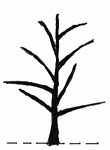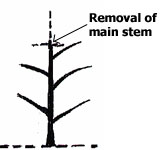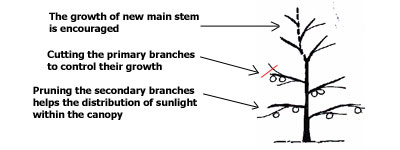Pruning is done a year after planting. Most durian clones bear fruit on primary and secondary branches. The durian has to be trained with a main stem with primary branches developing around it. A balanced branch arrangement as seen in Figure 1 is necessary to obtain the maximum yield potential.
Excess primary branches developed at acute angles compete with the main stem and have to be removed. At the first level, 5-8 primary branches are kept at about 75 cm above the soil level.
To strengthen the primary branches, the growth of the main stem is reduced by keeping it below 1.5 m tall. However the size of the primary branches should not exceed 30% of the main stem. The primary branches are bench cut to control their growth.
In the 4th year of growth, prune the secondary branches to help even out the distribution of sunlight through the canopy
Figures 1 (a-d) : Pruning of young durian trees

Year 1 (figure 1a) Good vegetative growth. No pruning is necessary.
Encourage the growth of main stem

Year 2 (figure 1b) Acute branches are removed
5-8 lateral primary branches are maintained in a balanced arrangement, the first level at about 75 cm above ground.

Year 3 (figure 1c) Removal of main stem to control plant height, to develop and strengthen primary lateral branches

Year 4 (figure 1d) Prune the secondary branches to help even out the distribution of sunlight through the canopy

